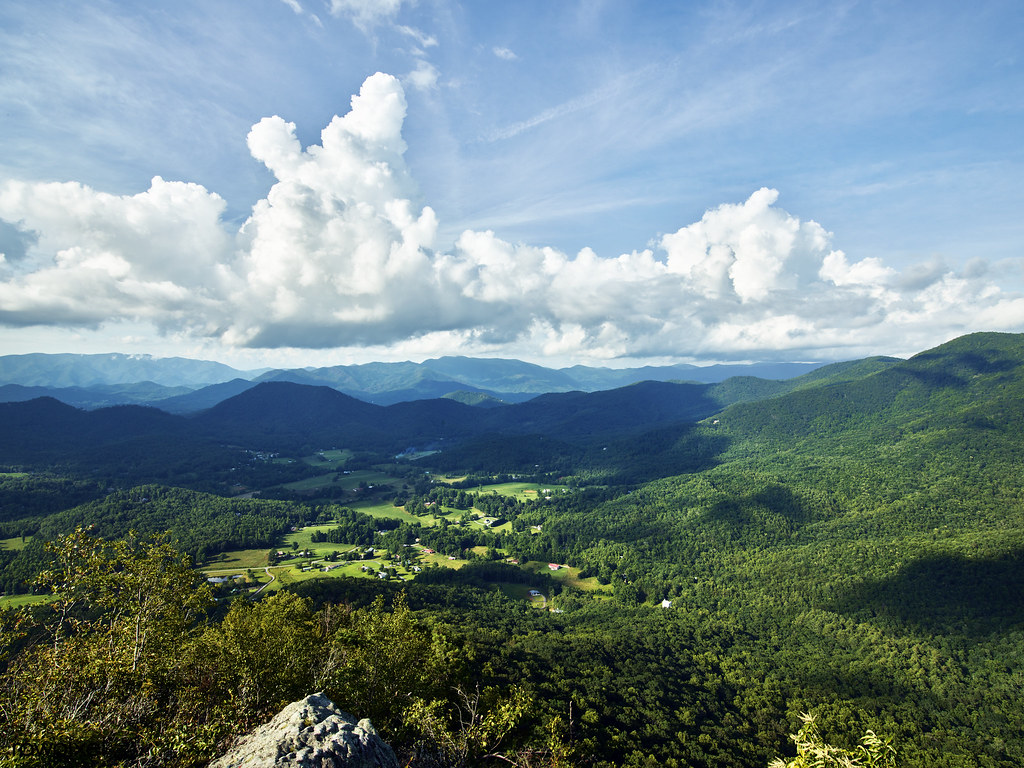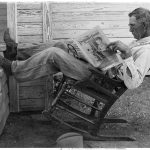Hawksbill. Table Rock. Canoe Creek.
These are places.
Crag. Croit. Rinn. Glen. Srath. Dook. Weem.
These are place-words, terms rooted in particular habitats, generated by people whose culture, livelihoods, and recreational hobbies are closely connected to the land. Place-words are cultivated by communities that have remained anchored to a single rib of earth long enough that they’ve developed neologisms within their own regional dialects or languages, each connoting a sense of, well, place.
Most of the words in the above list are either Scottish or Gaelic in origin, very likely spoken by many of the Scotch-Irish settlers who moved into the Blue Ridge Mountains starting in the eighteenth century, dispossessing the Cherokee and Catawba peoples who have called this place home for many centuries before that.
These morphemes often become fiercely nuanced because when you are so intimately familiar with your locale, including the flora and fauna—central parts of what the Appalachian essayist Wendell Berry considers “community”—there’s no small difference between the size or shape of a given physical landmark.
Faoi is Gaelic for “noisy stream,” while gairneag is used to denote “a noisy little stream.” And dreich, for Scots, refers to weather that is “overcast, misty, cold,” while smirr is used to describe “extremely fine, misty rain, close to smoke in appearance when seen from a distance.”
This brief glossary of northerly place-words is taken from Robert Macfarlane’s 2016 book, Landmarks, which he says is “about the power of language—strong style, single words—to shape our sense of place.” The very idea of “place-words” as different from other words is strange, because up until the digital age, before the internet deracinated us and globalization began homogenizing the world under the banner of market triumphalism, most words were place-words.
It is said that language is derived from, or rather, animated by the natural world, inspired by the birds, trees, brooks, and mammals that contribute to nature’s soundscape.
At least, originally. Now, our relationship with Mother Nature is increasingly severed by the wonderful and terrifying tools that we’ve created using motherboards and microprocessors.
We used to pay more attention to the voices of our non-human animal neighbors, but “today we participate almost exclusively with other humans and with our own human-made technologies,” writes the philosopher David Abram in The Spell of the Sensuous.
“For the largest part of our species’ existence,” Abram reminds us, “humans have negotiated relationships with every aspect of the sensuous surroundings, exchanging possibilities with every flapping form, with each textured surface and shivering entity that we happened to focus upon.”
If we don’t step away from our mind-narrowing laptops or silence our habit-forming smartphones long enough, we lose contact with place—the unique and particular medley of soil, air, water, and animals (including humans) that prompt us to live more through our bodies and landscapes, and less via our cybernetic avatars or virtual planes.
“Direct sensuous reality, in all its more-than-human mystery,” argues Abram, “remains the sole solid touchstone for an experiential world now inundated with electronically generated vistas and engineered pleasures; only in regular contact with the tangible ground and sky can we learn how to orient and to navigate in the multiple dimensions that now claim us.”
Among the numerous insights Macfarlane and Abram have for us disembodied moderns, two have gently enlivened me since I moved into this 1940s stone cottage situated on a few rural acres full of maples, white pines, hickories, oaks, eastern hemlocks, goldenrod, milkweed, mountain laurel, pokeweed, cardinals, toads, and orbweavers.
First, Appalachia is a singular place—a delineated bioregion, in fact—and these carven mountains are the very ground that nurtures our history, culture, and language. “Mountaineer families did not live at a certain place,” writes historian William R. Trotter, describing the early settlers of southern Appalachia. “They were part of the place itself, as much as the rocks and streams and meadows. This continued for generation after generation, until the people and their dwelling places became symbiotic on an almost molecular level.”
And, second, if we don’t bless ourselves with abundant time spent outside, in nature parks, protected woods, beloved gardens, budding orchards, odoriferous paddocks, or sanctifying bodies of water, among the non-human parts of our community, then we’re going to become all the more susceptible to the hollowing technological forces that pull us further into abstract, placeless, and discarnate ways of being.
To the uprooted and unmoored, Nature is merely a collection of resources, a pool of objects with economic value, rather than a mystical and unsettling world teeming with life and sentience.
If we disregard the power of place, not only will our ecosystems further suffer from the anthropogenic effects of climate change, mass extinction, pollution, soil degradation, and extraction, but we’ll become further atomized from one another, less committed to our neighbors’ well-being, our affinity for the local weakened by the allure of blue screens and scintillating promises of a computerized world without limits.
While my wife’s family has continuously inhabited this region since the mid-eighteenth century, it’s only become my home within the past few years (although I can claim several ancestors who settled in Appalachia around the same time before moving west of the Rocky Mountains in hopes of new opportunities and similarly fecund ecosystems).
We chose to root ourselves here for many reasons, including proximity to her family and the inherent resilience of the area, but primary among them is the fact that Appalachia still holds a semblance of regional identity, the largely rural expanse dotted mostly by small towns, many of which are relatively insulated from the community-erasing forces of consumerism and mass culture’s fabricated artifacts when compared to other sections throughout the United States.
Some families have been here for centuries.
In Burke County, North Carolina, that distinguished list includes the Ervins, Averys, Waltons, Corpenings, Pearsons, Bowmans, McDowells, Perkinses, Pattons, Berrys, Carswells, Brittains, Kincaids, McGimseys, and McKessons. Not to mention the numerous African Americans who were enslaved by some of these early families—the wealthy and influential slave-holding class referred to as “the Benevolent Opportunists” by local historian Edward J. Phifer, Jr.
Others have been here only a few decades, including families from the Hmong and Guatemalan/Mayan communities that have more recently enriched the Foothills region. And then some of us can only boast a few years of residency.
This retrospective provokes a few challenging questions at the nexus of community and a sense of place.
Do those whose families have lived here longer have a greater claim to this place than those whose shoes have only recently become adorned with the brick-colored Carolina clay that dries on one’s feet? Who gets to take upon themselves the name Appalachia? And, must one adopt certain cultural practices or embrace a particular cluster of petrified beliefs to declare oneself Appalachian?
It’s contentious ground, I know. But I think there are many fruitful ways to use the term Appalachian, and even more approaches to being Appalachian. Some people maintain that one must have family that has lived in these mountains for multiple generations, be born within Appalachia’s borders, currently reside here, or adopt a singular way of doing things. Some also use the term “Appalachian” to describe cultural relics, such as bluegrass, hand-made quilts, or moonshine, to name a few.
Alternatively, I prefer a more pluralistic and pragmatist method, a working definition with one’s claims to Appalachianness hinging on three reinforcing mindsets:
- A commitment to the common well-being of Appalachia that supports the interests of all its inhabitants (human and non-human animal)
- A strong affinity for the local that focuses one’s social and political eyes toward what’s happening within the geographical territory of Appalachia
- A general awareness of and connection to Appalachia’s particular history and cultures that fosters a communal consciousness of the region
All other qualifiers are tertiary. For me, being Appalachian is more about your frame of mind and daily responsibilities. It’s not just about genealogical heritage, although that can certainly be a part. At the root, it’s a loyalty to the Appalachian community.
Ultimately, if you’re not wed to the fate—both the prosperities and hardships—of this region, with its “blue-veiled coves and crystalline streams, perfumed by the dark, emerald-cold scent of balsam, fir, and mountain laurel,” to quote Trotter, again, why would you care to take upon yourself the name of Appalachia? Why would a communal moniker even matter to you?
Notably, many attempts to create a checklist of traits that christen one as Appalachian—such as being of Scotch-Irish descent, having a Christian faith, or speaking with a certain accent—soon become mired in xenophobic or prejudiced muck, inevitably excluding people who otherwise demonstrate not only a strong affinity to our region but a righteous passion for improving the lives of those who call these furrowed forests home.
I want “Appalachian” to be as inclusive a term as possible, without losing its geographical anchor and its fructifying localism. There are many paths up the mountain, so to speak. The important part is that you are laboring up that mountain with the rest of your Appalachian neighbors.
These questions would cause little debate or consternation without the importance of place tethering them. And, despite the erasure of communitarian mindsets and regional identity, place still matters. For many people. And so, I hope an invigorating sense of place will revive and further spread as more people become smart to the increasingly bitter fruits of mass culture and rootlessness that we’re continually forced to stomach.
Whichever way people prefer to categorize their Appalachianness, I take heart that they’ll commit themselves to the well-being of this place. Dedicate themself to this community. And embrace their obligation to this bioregion, to all its diverse creatures and floral creations.
In southern Scotland, a hope refers to a “small enclosed valley, especially one branching out from a main valley,” according to Macfarlane’s hoard of place-words. My ultimate invocation here is, then, that all my regional neighbors’ individual hopes eventually flow into the greater hope that is an Appalachia dedicated to egalitarian and communitarian values, ensuring a future that is sustainable, locally minded, and respectful toward the natural world that gives us life.
After all, we can’t experience a thriving community unless we have a healthy and beloved place that grounds it.
Image via Flickr






2 comments
Josh Kearns
This is really frustrating and makes me want to stop reading FPR. Can I write a rebuttal?
Jeffrey Bilbro
Our submissions are always open!
Comments are closed.